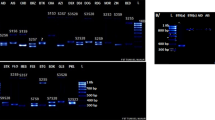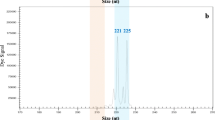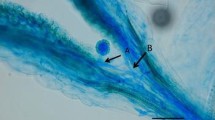Abstract
Chinese cherry (Prunus pseudocerasus) has many natural tetraploid species within Prunus. The pollen grains of tetraploid Chinese cherry are hetero-diploid, the two S-haplotypes in the pollen are a combination of two of the four possible S-haplotypes. The abnormal segregation ratios of pollen-S indicate that a few hetero-diploid pollen grains could inactivate self-stylar S-RNase inside the pollen tube and grow better into the self-ovaries than to the others. In this study, three Chinese cherry cultivars, “Daiba” (S 1 S 2 S 5 S 8 ), “Taishanganying” (S 1 S 2 S 4 S 6 ), and “Laiyangduanzhi” (S 1 S 2 S 8 S x ), were used to investigate the inheritance of hetero-diploid pollen-S alleles in non-self receptors. Genetic analysis showed that the distribution of S-haplotypes is unequally expressed in self- and cross-pollinated progenies. The S 2 -haplotype, which is found with lowest frequency in all progeny plants, is a likely lethal mutation. Moreover, the number of individuals with two different S-haplotypes was also unequal in the two cross-pollinated progenies. Notably, the number of individuals with S 1 S 5 and S 1 S 8 genotypes was larger than other genotypes in the cross-pollinated progeny of “Laiyangduanzhi” × “Daiba”, and the number of individuals with S 1 S 4 , S 1 S 6 , and S 4 S 6 genotypes was larger than S 2 -haplotypes in the cross-pollinated progeny of “Laiyangduanzhi” × “Taishanganying”. These results indicate that only a few genotypes of hetero-diploid pollen grains have the capability to grow into the ovaries of “Laiyangduanzhi”. Interestingly, the pollen grains with S 5 S 8 genotypes, which is self-compatible, was incompatible with the styles of “Laiyangduanzhi”, while the pollen grains with S 1 S 8 , S 1 S 6 and S 4 S 6 genotypes, which are self-incompatible, were compatible with the styles of “Laiyangduanzhi”.

Similar content being viewed by others
References
Anderson MA, Cornish EC, Mau SL, Williams EG, Hoggart R, Atkinson A, Bonig I, Grego B, Simpson R, Roche PJ (1986) Cloning of cDNA for a stylar glycoprotein associated with expression of self-incompatibility in Nicotiana alata. Nature 321:38–44
Bŏsković RI, Wolfram B, Tobutt KR, Cerović R, Sonneveld T (2006) Inheritance and interactions of incompatibility alleles in the tetraploid sour cherry. Theor Appl Genet 112:315–326
Chawla B, Bernatzky R, Liang W, Marcotrigiano M (1997) Breakdown of self-incompatibility in tetraploid Lycopersicon peruvianum: inheritance and expression of S-related proteins. Theor Appl Genet 95:992–996
Crane MB, Lewis D (1942) Genetical studies in pears. III. Incompatibility and sterility. J Genet 43:31–42
De Nettancourt D, Saccardo F, Laneri U, Capaccio E (1974) Self-incompatibility in a spontaneous tetraploid of Lycopersicon peruvianum Mill. In: Polyploidy and induced mutations in plant breeding. IAEA, Vienna, pp 77–84
Golz JF, Clarke AE, Newbigin E (2000) Mutational approaches to the study of self-incompatibility: revisiting the pollen-part mutants. Ann Bot 85:95–103
Gu C, Liu Q, Yang Y, Zhang S, Khan M, Wu J, Zhang S (2013) Inheritance of hetero-diploid pollen S-haplotype in self-compatible tetraploid Chinese cherry (Prunus pseudocerasus Lindl). PLoS One 8:e61219
Gu C, Wu J, Zhang SJ, Yang YN, Wu HQ, Khan MA, Zhang SL, Liu QZ (2011) Molecular analysis of eight SFB alleles and a new SFB-like gene in Prunus pseudocerasus and Prunus speciosa. Tree Genet Genomes 7:891–902
Gu C, Wu J, Zhang SJ, Yang YN, Wu HQ, Tao ST, Zhang SL (2012) Characterization of the S-RNase genomic DNA allele sequence in Prunus speciosa and P. pseudocerasus. Sci Hortic 144:93–101
Gu C, Zhang SL, Huang SX, Heng W, Liu QZ, Wu HQ, Wu J (2010) Identification of S-genotypes in Chinese cherry cultivars (Prunus pseudocerasus LindI.). Tree Genet Genomes 6:579–590
Hauck NR, Ikeda K, Tao R, Iezzoni AF (2006a) The mutated S1-haplotype in sour cherry has an altered S-haplotype-specific F-box protein gene. J Hered 97:514–520
Hauck NR, Yamane H, Tao R, Iezzoni AF (2002) Self-compatibility and incompatibility in tetraploid sour cherry (Prunus cerasus L.). Sex Plant Reprod 15:39–46
Hauck NR, Yamane H, Tao R, Iezzoni AF (2006b) Accumulation of nonfunctional S-haplotypes results in the breakdown of gametophytic self-incompatibility in tetraploid Prunus. Genetics 172:1191–1198
Herrero M, Hormaza JI (1996) Pistil strategies controlling pollen tube growth. Sex Plant Reprod 9:343–347
Huang SX, Wu HQ, Li YR, Wu J, Zhang SJ, Heng W, Zhang SL (2008) Competitive interaction between two functional S-haplotypes confer self-compatibility on tetraploid Chinese cherry (Prunus pseudocerasus Lindl. CV. Nanjing Chuisi). Plant Cell Rep 27:1075–1085
Hulskamp M, Schneitz K, Pruitt RE (1995) Genetic evidence for a long-range activity that directs pollen tube guidance in Arabidopsis. Plant Cell 7:57–64
Ikeda K, Igic B, Ushijima K, Yamane H, Hauck NR, Nakano R, Sassa H, Iezzoni AF, Kohn JR, Tao R (2004) Primary structural features of the S haplotype-specific F-box protein, SFB, in Prunus. Sex Plant Reprod 16:235–243
Kao TH, Tsukamoto T (2004) The molecular and genetic bases of S-RNase-based self-incompatibility. Plant Cell 16(Suppl):S72–S83
Lai Z, Ma W, Han B, Liang L, Zhang Y, Hong G, Xue Y (2002) An F-box gene linked to the self-incompatibility (S) locus of Antirrhinum is expressed specifically in pollen and tapetum. Plant Mol Biol 50:29–42
Liu QZ, Gu C, Zong XJ, Wang JW (2012) Frequency and distribution of S-alleles in a native population of Chinese cherry (Prunus pseudocerasus LindI.). J Hortic Sci Biotech 87:144–148
Luu DT, Qin X, Laublin G, Yang Q, Morse D, Cappadocia M (2001) Rejection of S-heteroallelic pollen by a dual-specific S-RNase in Solanum chacoense predicts a multimeric SI pollen component. Genetics 159:329–335
Matton DP, Luu DT, Xike Q, Laublin G, O'Brien M, Maes O, Morse D, Cappadocia M (1999) Production of an S RNase with dual specificity suggests a novel hypothesis for the generation of new S alleles. Plant Cell 11:2087–2097
McClure BA, Haring V, Ebert PR, Anderson MA, Simpson RJ, Sakiyama F, Clarke AE (1989) Style self-incompatibility gene products of Nicotlana alata are ribonucleases. Nature 342:955–957
Moutinho A, Hussey PJ, Trewavas AJ, Malhó R (2001) cAMP acts as a second messenger in pollen tube growth and reorientation. Proc Natl Acad Sci U S A 98:10481–10486
Pandy KK (1968) Colchicine induced changes in the self-incompatibility behavior of Nicotiana. Genetica 39:257–271
Qi YJ, Wu HQ, Cao YF, Wu J, Tao ST, Zhang SL (2011) Heteroallelic diploid pollen led to self-compatibility in tetraploid cultivar‘Sha 01’ (Pyrus sinkiangensis Yü). Tree Genet Genomes 7:685–695
Qiao H, Wang F, Zhao L, Zhou J, Lai Z, Zhang Y, Robbins TP, Xue Y (2004) The F-box protein AhSLF-S2 controls the pollen function of S-RNase-based self-incompatibility. Plant Cell 16:2307–2322
Qu HY, Shang ZL, Zhang SL, Liu LM, Wu JY (2007) Identification of hyperpolarization-activated calcium channels in apical pollen tubes of Pyrus pyrifolia. New Phytol 174:524–536
Sassa H, Nishio T, Kowyama Y, Hirano H, Koba T, Ikehashi H (1996) Self-incompatibility (S) alleles of the Rosaceae encode members of a distinct class of the T2/S ribonuclease superfamily. Mol Gen Genet 250:547–557
Sijacic P, Wang X, Skirpan AL, Wang Y, Dowd PE, McCubbin AG, Huang S, Kao TH (2004) Identification of the pollen determinant of S-RNase-mediated self-incompatibility. Nature 429:302–325
Singh DP, Jermakow AM, Swain SM (2002) Gibberellins are required for seed development and pollen tube growth in Arabidopsis. Plant Cell 14:3133–3147
Sonneveld T, Robbins TP, Bŏsković R, Tobutt KR (2001) Cloning of six cherry self-incompatibility alleles and development of allele-specific PCR detection. Theor Appl Genet 102:1046–1055
Stout AB, Chandler C (1942) Hereditary transmission of induced tetraploidy and compatibility in fertilization. Science 96:257–258
Tao R, Yamane H, Sassa H, Mori H, Gradziel TM, Dandekar AM, Sugiura A (1997) Identification of stylar RNases associated with gametophytic self-incompatibility in almond (Prunus dulcis). Plant Cell Physiol 38:304–311
Thompson KF (1972) Competitive interaction between two S alleles in a sporophytically-controlled incompatibility system. Heredity 28:1–7
Tsukamoto T, Ando T, Watanabe H, Marchesi E, Kao TH (2005) Duplication of the S-locus F-box gene is associated with breakdown of pollen function in an S-haplotype identified in a natural population of self-incompatible Petunia axillaris. Plant Mol Biol 57:141–153
Tsukamoto T, Hauck NR, Tao R, Jiang N, Iezzoni AF (2006) Molecular characterization of three non-functional S-haplotypes in sour cherry (Prunus cerasus). Plant Mol Biol 62:371–383
Tsukamoto T, Potter D, Tao R, Vieira CP, Vieira J, Iezzoni AF (2008) Genetic and molecular characterization of three novel S-haplotypes in sour cherry (Prunus cerasus L.). J Exp Bot 59:3169–3185
Ushijima K, Sassa H, Dandekar AM, Gradziel TM, Tao R, Hirano H (2003) Structural and transcriptional analysis of the self-incompatibility locus of almond: identification of a pollen-expressed F-box gene with haplotype-specific polymorphism. Plant Cell 15:771–781
Vidali L, McKenna ST, Hepler PK (2001) Actin polymerization is essential for pollen tube growth. Mol Biol Cell 12:2534–2545
Wang Y, Wang X, McCubbin AG, Kao TH (2003) Genetic mapping and molecular characterization of the self-incompatibility (S) locus in Petunia inflata. Plant Mol Biol 53:565–580
Wolters-Arts M, Lush WM, Mariani C (1998) Lipids are required for directional pollen-tube growth. Nature 392:818–821
Wu J, Gu C, Zhang SL, Zhang SJ, Wu HQ, Heng W (2009) Identification of S-haplotype-specific S-RNase and SFB alleles in native Chinese apricot (Prunus armeniaca L.). J Hortic Sci Biotech 84:645–652
Wu J, Shang Z, Jiang X, Moschou PN, Sun W, Roubelakis-Angelakis KA, Zhang S (2010) Spermidine oxidase-derived H2O2 regulates pollen plasma membrane hyperpolarization-activated Ca2+-permeable channels and pollen tube growth. Plant J 63:1042–1053
Xue Y, Carpenter R, Dickinson HG, Coen ES (1996) Origin of allelic diversity in Antirrhinum S locus RNases. Plant Cell 8:805–814
Yamane H, Ikeda K, Hauck NR, Iezzoni AF, Tao R (2003) Self-incompatibility (S) locus region of the mutated S 6 -haplotype of sour cherry (Prunus cerasus) contains a functional pollen S allele and a non-functional pistil S allele. J Exp Bot 54:2431–2437
Acknowledgments
This work was supported by the National Natural Science Foundation of China (31071759 and 31201604) and the National Department Public Benefit Research Foundation (200903044).
Data Archiving Statement
The full-length sequence of P. pseudocerasus S 1 -RNase, S 2 -RNase, S 4 -RNase, S 5 -RNase, S 6 -RNase, S 8 -RNase, SFB 1 , SFB 4 , SFB 5 , and SFB 6 alleles had been submitted in GeneBank with respective accession numbers: HQ913630, FJ543097, FJ543098, HQ913631, FJ543099, HQ913635, HQ913632, HQ913633, EU253964, and HQ913634.
Author information
Authors and Affiliations
Corresponding authors
Additional information
Communicated by E. Dirlewanger
Electronic supplementary material
Below is the link to the electronic supplementary material.
Table S1
Rates of fruit setting in self- or cross-pollination of four cultivars (DOC 29 kb)
Table S2
Sequences of primers used in this study (DOC 30 kb)
Table S3
Gamete constitutions in the self-progeny of “Laiyangduanzhi” (DOC 39 kb)
Table S4
Gamete constitutions in the progeny of “Laiyangduanzhi” × “Daiba” (DOC 43 kb)
Table S5
Gamete constitutions in the progeny of “Laiyangduanzhi” × “Taishanganying” (DOC 44 kb)
Fig. S1
PCR products of S-RNases amplified with primers Pru-C2 and Pa-C3R from genomic DNA of the parent (“Laiyangduanzhi”) and some of their self-pollinated progeny. M. Ladder marker; L. “Laiyangduanzhi”; 1-45. Forty-five different individuals (DOC 395 kb)
Fig. S2
PCR products of S-RNases amplified with primers Pru-C2 and Pa-C3R from genomic DNA of two parents (“Laiyangduanzhi” and “Daiba”) and some of their cross-pollinated progeny. M. Ladder marker; L. “Laiyangduanzhi”; T. “Daiba”; 1-44. Forty-four different individuals. (DOC 517 kb)
Fig. S3
PCR products of S-RNases amplified with primers Pru-C2 and Pa-C3R from genomic DNA of two parents (“Laiyangduanzhi” and “Taishanganying”) and some of their cross-pollinated progeny. M. Ladder marker; L. “Laiyangduanzhi”; G. “Taishanganying”; 1-44. Forty-four different individuals. (DOC 545 kb)
Rights and permissions
About this article
Cite this article
Gu, C., Liu, QZ., Khan, M.A. et al. Hetero-diploid pollen grains that represent self-compatibility are incompatible with non-self receptors in tetraploid Chinese cherry (Prunus pseudocerasus Lindl). Tree Genetics & Genomes 10, 619–625 (2014). https://doi.org/10.1007/s11295-014-0708-2
Received:
Revised:
Accepted:
Published:
Issue Date:
DOI: https://doi.org/10.1007/s11295-014-0708-2




